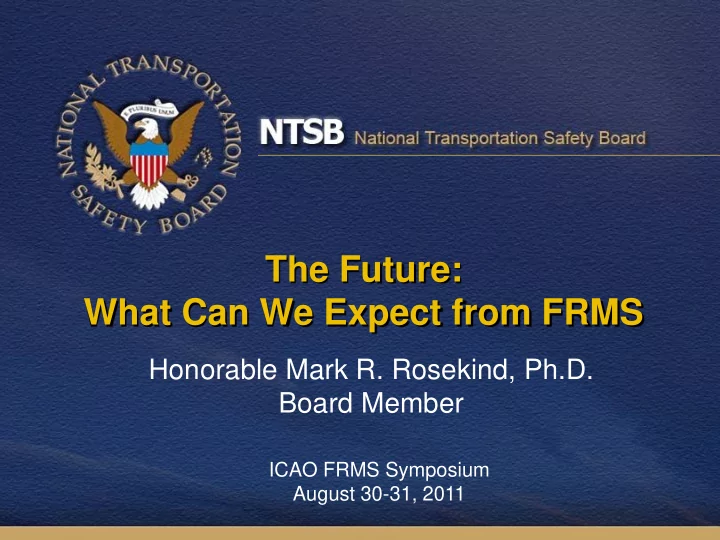

The Future: What Can We Expect from FRMS Honorable Mark R. Rosekind, Ph.D. Board Member ICAO FRMS Symposium August 30-31, 2011
Fatigue Risk Management Enhance safety!
Go! Flight 1002 • early starts, multiple segment days, sleep apnea
Guantanamo Bay Cuba First NTSB aviation accident to cite fatigue as probable cause • acute sleep loss, sleep debt, circadian disruption
Uncontrolled In-Flight Collision with Terrain AIA Flight 808, Douglas DC-8-61, N814CK U.S. NAS, Guantanamo Bay, Cuba, August 18, 1993 “The National Transportation Safety Board determines that the probable causes of this accident were the impaired judgment, decision making, and flying abilities of the captain and flight crew due to the effects of fatigue…”
Owatonna, MN/July 31, 2008 8 fatalities
NTSB Fatigue Recommendations • MOST WANTED since 1990 • ~200 fatigue recommendations
Complex Issue: Requires Multiple Solutions Scheduling Policies and Practices Education Organizational Strategies Raising Awareness Healthy Sleep Vehicle and Environmental Strategies Research and Evaluation
Success requires . . . A culture change that supports different attitudes and behaviors
Different Attitude . . . Fatigue is a safety risk
Fatigue Risk Management How fatigue science has evolved and where it still needs to go
1980 Congressional Request to NASA • NASA created Fatigue/Jet Lag Program: 1) determine extent of fatigue, sleep loss, and circadian disruption in flight operations 2) determine how fatigue affected flight crew performance 3) develop strategies to maximize performance and alertness during flight operations
Fatigue Science has Evolved • Fatigue is a safety risk in aviation operations: errors, incidents, accidents • Fatigue factors include: sleep loss, circadian disruption, continuous hours awake, sleep disorders, medications, more . . . • Operational factors include: rest opportunity, duty length, time of day (duty/rest), time zones, recovery (sleep/circadian), predictability, workload, more . . .
Fatigue Science Still Needs . . . • Prevalence: errors, incidents, accidents • Individual differences • Operational differences • Recovery: sleep/circadian • Tools: technology/models • Centralized/shared databases • Lab/simulator/operational data • Standardized measures and methods
Success requires . . . A culture change that supports different attitudes and behaviors
Different Behavior . . . Fatigue Risk Management
Fatigue Risk Management Managing risks rather than eliminating a problem
Eliminate Fatigue? Physiological Challenge There is no . . . - simple solution - single solution - one-size-fits-all - “magic bullet”
Hours of Service • Necessary but not sufficient • Prescriptive approach does not address: - complexity - operational differences - individual differences - evolving technology/operations
FRMS Approach • Define processes • Performance-based - regulations - operations • Much more . . .
PG&E/San Bruno Gas Pipeline Explosion
San Bruno Gas Pipeline Explosion Findings: • The Pipeline and Hazardous Materials Safety Administration integrity management inspection protocols are inadequate. • . . . have not incorporated the use of effective and meaningful metrics as part of their performance-based pipeline safety management programs Probable Cause: • Also contributing to the accident was the California Public Utility Commission’s failure to detect the inadequacies of the Pacific Gas and Electric Company’s pipeline integrity management program.
San Bruno Gas Pipeline Explosion Safety Recommendation: address the (1) need to expand the program’s use of meaningful metrics; (2) adequacy of its inspection protocols for ensuring the completeness and accuracy of pipeline operators’ integrity management program data; (3) adequacy of its inspection protocols for ensuring the incorporation of an operator’s leak, failure, and incident data in evaluations of the operator’s risk model; and (4) benefits of establishing performance goals for pipeline operators. Aviation translation . . .
San Bruno Gas Pipeline Explosion Safety Recommendation: Develop and implement standards for integrity management and other performance-based safety programs that require operators of all types of pipeline systems to regularly assess the effectiveness of their programs using clear and meaningful metrics, and to identify and then correct deficiencies.; and (2) make those metrics available in a centralized database Aviation translation . . .
Performance-Based Safety • vs. prescriptive regulations • Systems approach: - Federal regulator - Industry - Company - Individual
NTSB Safety Recommendation: Fatigue Management Systems • Develop guidance based on empirical and scientific evidence for operators to establish fatigue management systems • Develop and use a methodology that will continually assess the effectiveness of fatigue management systems
FRMS: The Future . . . • Shared responsibility • Acknowledge/address complexity • Complex issue requires multiple solutions • Science-based/data-driven solutions • Evolve/integrate new science/data • Continuous evaluation/enhancement
Recommend
More recommend